Weston Whistle in Cherry Wood Review
(Review written May 2006)
- Preface
- Dale Wisely of Chiff and Fipple recently sent me a Weston whistle to review that he hadn't been able to find time for. There was a Weston wooden whistle tour on the Gaelic Crossings web board a while back, but I was too busy to get in on it at the time. I'm glad that the opportunity to review one of these whistles has fallen into my lap!
- At a Glance
- Whistle Reviewed
- Weston Whistle in Cherry Wood
- Models Available
- C&D whistles in copper, chrome, and wood.
- How Acquired
- Product sample, via Dale Wisely
- Construction
- Wood with Wooden Fipple plug
- Price at Time of Review (in US Dollars unless otherwise noted)
- £50.00 (add £15.00 for a presentation box if desired)
- Available From
-
Weston Whistles
- Appearance
- I think the Weston whistle kind of looks like a Syn whistle, probably due to the brass pins holding everything together. It's worth noting that the pins on the Weston are pretty small and understated. Overall, the whistle is well executed, clean and well finished, and shows good attention to detail. The cherry wood is really nice looking with an nice grain pattern. This whistle is non-tunable, and Simon tells me he tries to avoid making tunable whistles, but I get the impression he will if you really want one--he did send me a pic of one in C that looked every bit as well-executed as this one.
-
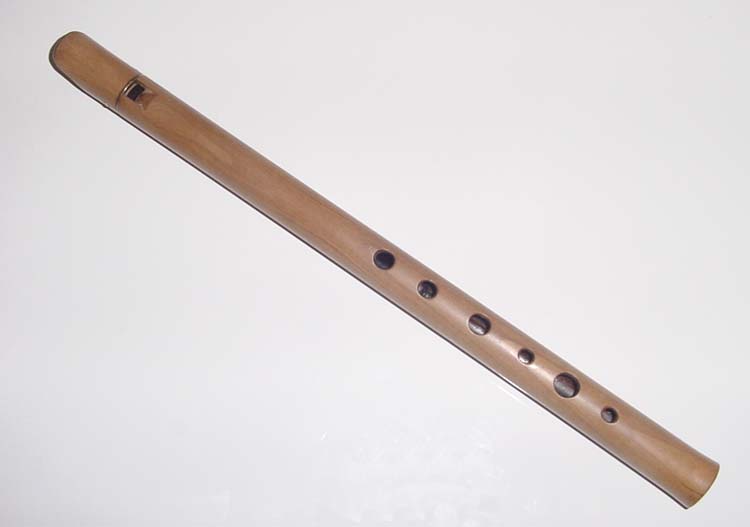
Here's the full whistle. You can see the nice creamy tan color of the cherry wood. At this distance, it's a little hard to see the grain pattern, but it becomes more apparent on closer inspection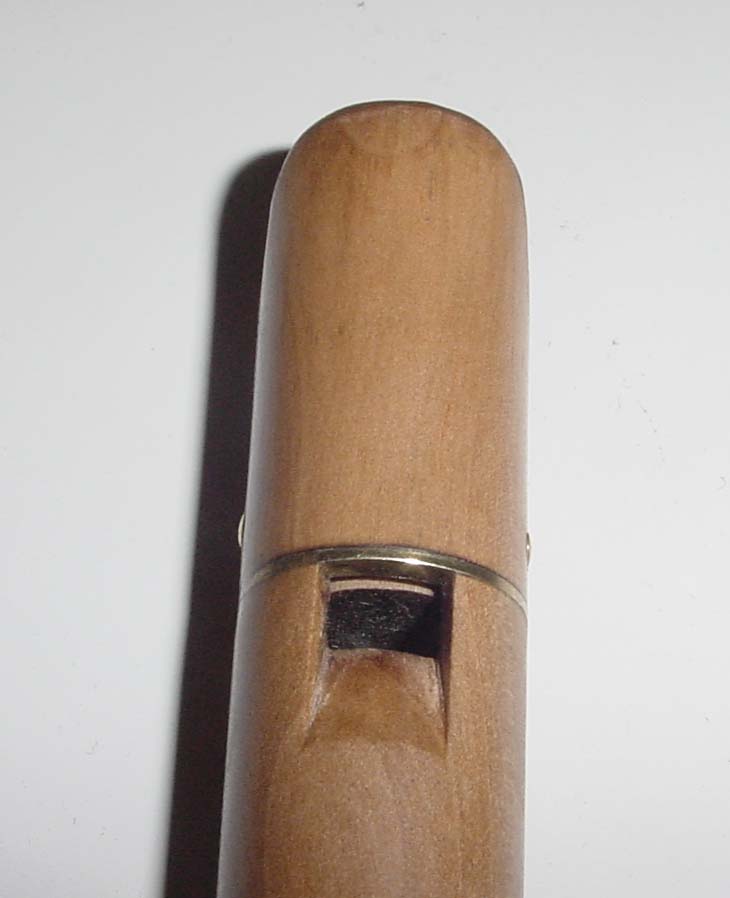
The head of the whistle. There's a thin bit of metal here between the head and the body, and the head is held together by a couple of brass pins. I think this is the only metal in the entire whistle. A tuning slide would, of course, have some metal as well.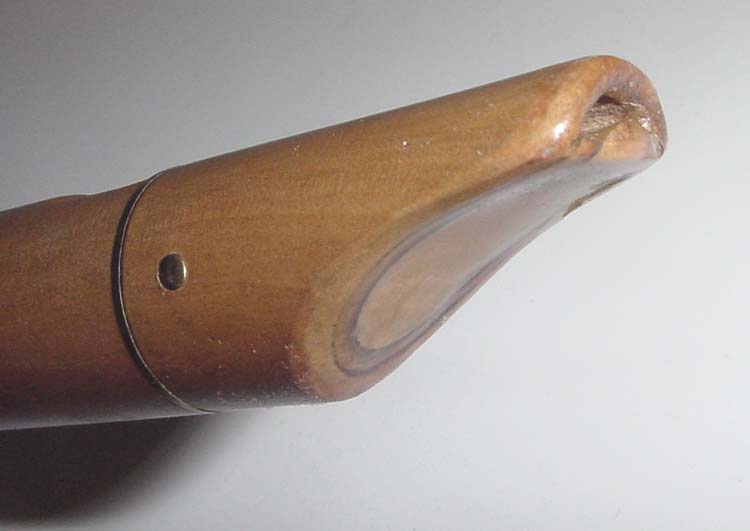
Another angle on the head. Here, you can get a better look at the pins, and the fipple angle. The Weston is a little less stubby than many high-end whistles, and will probably need much less adjustment when moving from low-end whistles like Generations. Contrast this to Susatos and Abells, which have extremely stubby mouthpieces, and generally take some getting used to. Unlike most whistles I've played, the fipple juts out just a bit right where the fipple forms the "floor" part of the windway, giving this whistle a bit of an "underbite" feel. I don't think the fipple's out of alignment, because it's perfectly flush everywhere else. It's only a very slight amount, probably not even 1/16 of an inch. It doesn't bother me, but I thought I'd mention it since it was a unique feature.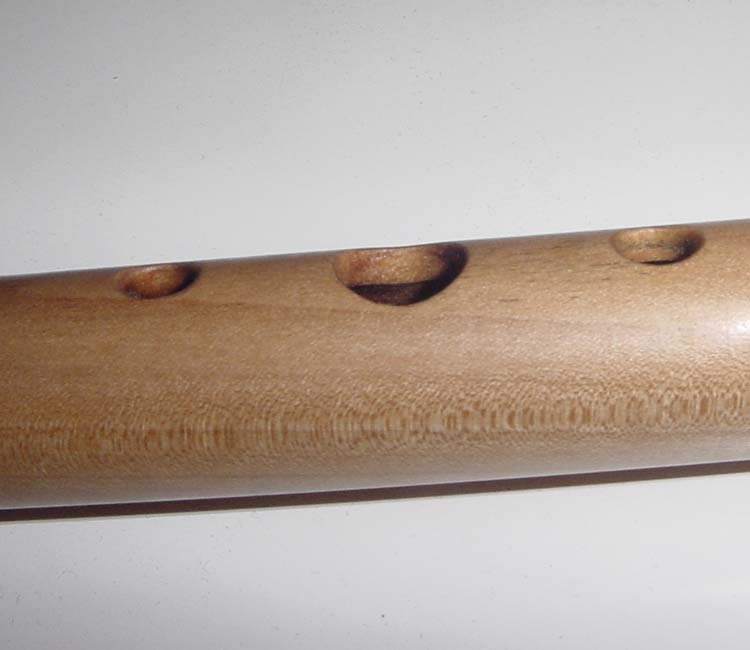
The last three holes of the whistle. They almost have a "wood burned" look, which I assume is a consequence of Simon's sanding process, as that same look is evident on the end of the whistle.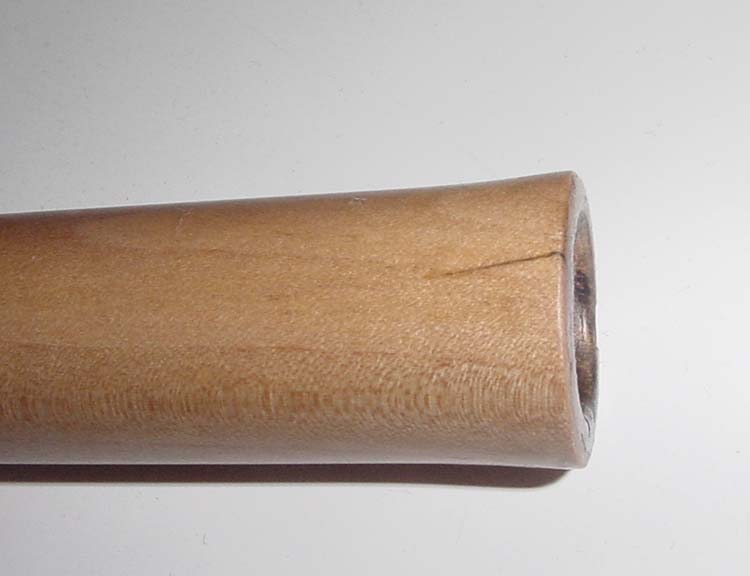
The end of the whistle, showing the very slight flair. The more I play whistles, the more I like this feature in them. I have this (irrational, I'm sure) feeling that the slightly flared end protects against cracking better than banded metal.
- Playing Characteristics
-
Sound clips of the whistle:
The Hag's PurseVolume: Slightly above average. The whistle is perhaps not quite as loud as a Susato, but it's definitely louder than your standard inexpensive whistle.
Responsiveness: Quick. I didn't have any problems playing this whistle up to speed.
Tuning: In tune along it's range. The first octave (especially the D) requires less breath than you'd expect..it's easy to blow sharp. here's a big gap between first and second octave on the breath, and you have to push the top B to get it into tune. But it's not as much as a fight up there as some whistles I've played, After a while, I got used to it.
C-natural: This was the only negative I found in the entire whistle. OXXOOO and OXXXOX both produce a sharp C-natural, and OXXXXXO produces one that's flat. I couldn't find a cross-fingering that produced an in-tune c-natural, so this whistle will require half-holing. I probably wouldn't even bother with half-holing on fast tunes, but the fingerings are 10-20 cents off, so I would definitely have to on slow tunes where the dissonance would be clear.
Hole size and placement: The holes are well rounded, evenly spaced, and a bit on the smallish side, making them easy to cover, but not as easy to half-hole.
Air volume requirements: A little higher than my inexpensive whistles. I do find myself taking breaths more often on this whistle, but not to the extreme. Perhaps a couple notes earlier than I normally would.
Air pressure requirements: Low in the first octave, and higher in the second octave. You really should be comfortable supporting a whistle with your diaphragm and pushing a bit (like with Overton whistles) to get the most out of the second octave.
Clogging: The whistle never clogged up on me, though after extended playing it did lose a little responsiveness due to moisture. I probably wouldn't use Duponol on this whistle unless it was my primary instrument.
Wind Resistance: Incredible! I played this whistle a couple weeks ago when we had the big thunderstorms and tornado warnings. The wind outside was strongly gusty and unpredictable. I think I only lost one note to the wind while playing tunes in those challenging circumstances.
- Summary
- Good whistle! Especially the amazing outdoor playability. Usually, when the wind is bad enough, the Susato is my fallback choice, but I could easily see myself playing on of these if I didn't want to play a plastic whistle. At approximately $95.00 US, it's a little less expensive than a Burke or a Silkstone, and I think it sits in that niche rather nicely. With a Weston, you get a little more whistle than you might expect for the price. I would have no problem performing solo at renaissance festivals and such with this whistle, though I'd likely be a bit shy about the C-natural until I got used to half-holing it. (Editors note from 2019: I have no recollection of ever learning this tune. Nor is the version I'm playing here exactly like any version I can find on the internet. Maddening!)